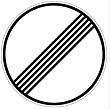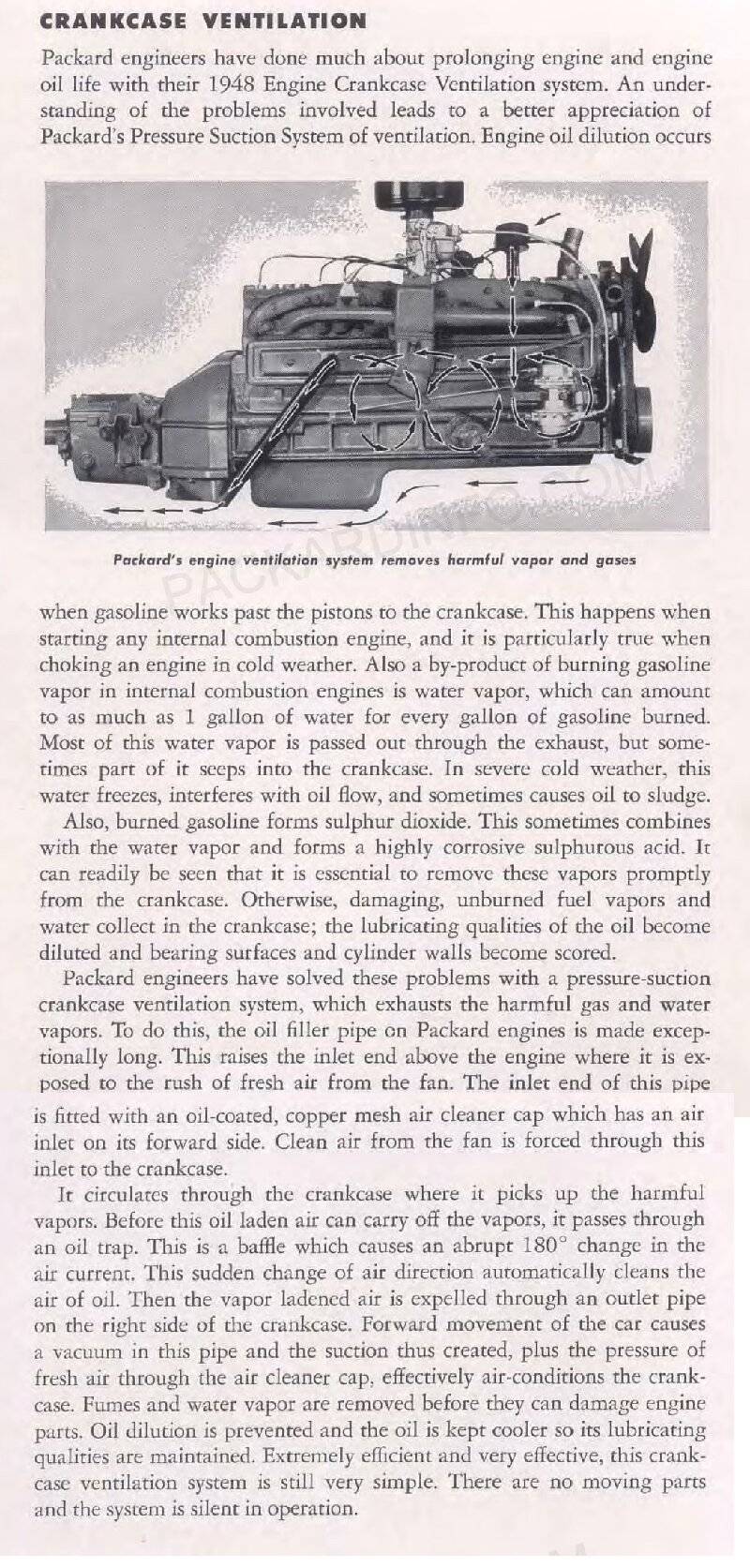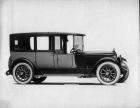|
Re: How to add a PCV Valve to a 1949 Packard
|
||||
|---|---|---|---|---|
|
Home away from home
|
Posted on: 2017/9/15 14:43
|
|||
|
||||
|
Re: How to add a PCV Valve to a 1949 Packard
|
||||
|---|---|---|---|---|
|
Forum Ambassador

|
I'm with Jim on this, if you're really getting annoying fumes and more than just the occasional drop of oil from the road draft tube you probably have excessive engine blow-by from worn cylinder bores, pistons and rings. The reason the Packard taxi engines had positive crankcase ventilation is that traditionally taxis spent considerable time idling and stationary, and road draft tubes only provide ventilation when the vehicle is in forward motion.
Posted on: 2017/9/16 0:20
|
|||
|
||||
|
Re: How to add a PCV Valve to a 1949 Packard
|
||||
|---|---|---|---|---|
|
Home away from home

|
My wife first mentioned that she noticed the occasional smell of "engine or exhaust", and I also notice it only once in a while. Since my engine is recently rebuilt, I don't think it is the rings. I can double check my new exhaust to make sure nothing is leaking there also.
Personally, I like trying to "teach an old dog new tricks" so I see this as an improvement that is possible to make and still keep that character of the car. I'm not putting in a small block chevy here! If you believe that having a closed crankcase will improve oil and hence engine life, then it should be a reasonable thing to do. (Keeps oil cleaner, and reduces condensation in the crankcase of water and acids) It can be debated if it helps just like we can debate if full flow oil filtering is better or worse than bypass oil filtering. Anyway that is why I'm considering it. There are quite a few people that converted old fords,chevys and others to have a pcv. The HAMB also has a handfull of threads about it. Wes, I had read that inline 6cyl chevy website, and that kind of made me sensitive to the notion that not all PCVs are equal. Thanks for the link. They have some cool tech articles.
Posted on: 2017/9/18 9:04
|
|||
|
1953 Clipper Delux Club Sedan, 1969 912, 1990 Miata, 2009 Ford S-Max.
|
||||
|
||||
|
Re: How to add a PCV Valve to a 1949 Packard
|
||||
|---|---|---|---|---|
|
Forum Ambassador
|
The way the vent tube is positioned any leaks that allow air into the body would be a likely source for the occasional smell. Gasket around the heater, poorly sealing air vent flapper valve rubber, the duct hoses slightly askew, and the openings for the pedals are all prime candidates. The weather strip contact under the doors is another good place to look.
Back in the day Packard had some problems with the seals around tail lights and trunk lid on some models. As the car went down the road it developed a higher pressure area behind the car that pushed dust and fumes into the trunk which eventually found the way into the passenger area.
Posted on: 2017/9/18 9:47
|
|||
|
Howard
|
||||
|
||||
|
Re: How to add a PCV Valve to a 1949 Packard
|
||||
|---|---|---|---|---|
|
Home away from home

|
Good points Howard. The passenger door seal is not yet installed, and I need to check the pedal seals. Fresh air ducts and flapper seals are new, but sealing any possible air leaks into the body is a smart thing to do first.
I emailed the people that make that fancy PCV, and asked about carb settings after installing in a car that previously had a road draught tube. He said only idle adjusting is needed, and the amount of air that goes through the PCV while driving is small or negligable compared to what goes through the throat of the carb.
Posted on: 2017/9/19 13:19
|
|||
|
1953 Clipper Delux Club Sedan, 1969 912, 1990 Miata, 2009 Ford S-Max.
|
||||
|
||||
|
Re: How to add a PCV Valve to a 1949 Packard
|
||||
|---|---|---|---|---|
|
Home away from home
|
This is a very interesting thread. I was painting my vent tube last night and I started wondering why is this thing so big, and how much dust and other contaminates are being introduced into my oil.
This discussion make me wonder about the merits of adding a PVC valve to my car, but for the amount of miles I will put on the car, which are all on pavement, I don't think there is a need. Not to mention I like to keep things as original as possible, and one of those things is the smell.
Posted on: 2023/8/6 10:00
|
|||
|
||||
|
Re: How to add a PCV Valve to a 1949 Packard
|
||||
|---|---|---|---|---|
|
Home away from home
|
There should be no need to add a PCV valve. The stock ventilation system is very efficient, and an engine in good condition will not emit signficant amounts of fumes or oil from the draft pipe or oil filler.
The straight 8s used the crankshaft as a blower to move air through the crankcase. The outlet tube was positioned to discharge into the air stream under the car when it was moving. When going slow or standing still the spinning crank shaft moved air through the engine, perhaps assisted by the radiator fan. Poorly seating rings, slapping pistons, and loose bearings all add to the amount of oil mist escaping from the crankase. I'd think carburetor settings would need to be adjusted to use a PCV valve on an older engine. When engines begin to wear out, it's common for the blowby and bearing splash to overcome the PCV system's capacity when the engine is loaded, which results in oil leakage, oil being forced into the air filter or out the oil filler or any other location that will allow it. PCV systems move only a low volume of air at idle. they move more air at higher engine speeds at partial load, and move very little air at full throttle. A proper PCV system will have a calibrated restriction at the air inlet point which will act to keep a slight vacuum on the crankcase under most operating conditions.
Posted on: 2023/8/6 10:18
|
|||
|
||||
|
Re: How to add a PCV Valve to a 1949 Packard
|
||||
|---|---|---|---|---|
|
Home away from home
|
Quote:
Agreed, best to leave things original. There are hundreds of modifications a person could do, but then why own a vintage car!?!? 🤔
Posted on: 2023/8/6 10:24
|
|||
|
||||
|
Re: How to add a PCV Valve to a 1949 Packard
|
||||
|---|---|---|---|---|
|
Forum Ambassador
|
The way the vent system and draft tube works doubt there is much in the way of dust or contaminates getting into the oil thru the large diameter tube.
Except for the taxi engines where they did install a PCV system -- probably to adhere to big city regulations for engines which did a lot of idling -- Packard used the same basic ventilation system for years. One of the most complete explanations of the vent system and large draft tube is in the 48 fact book.
Posted on: 2023/8/6 10:27
|
|||
|
Howard
|
||||
|
||||

 ventilation.jpg (239.38 KB)
ventilation.jpg (239.38 KB)







